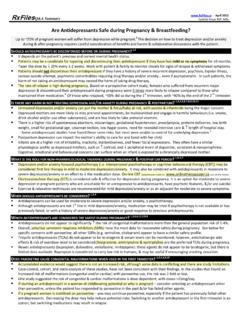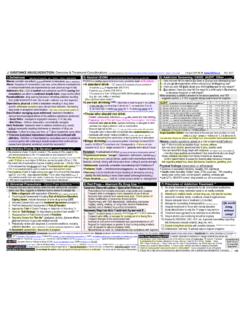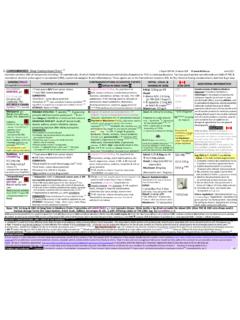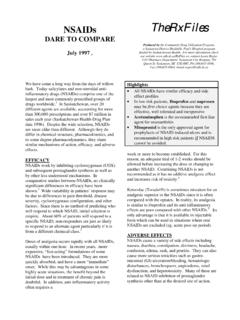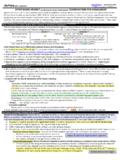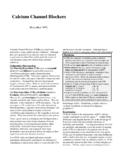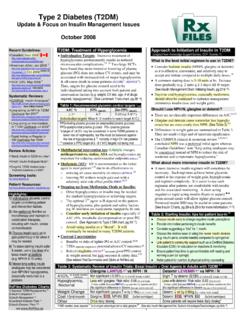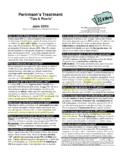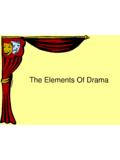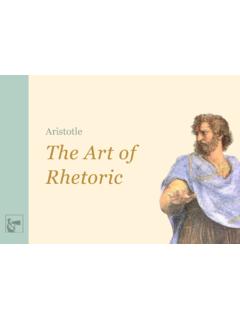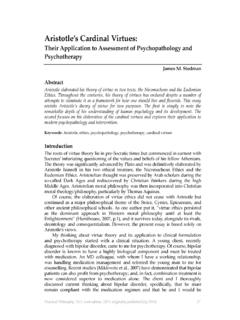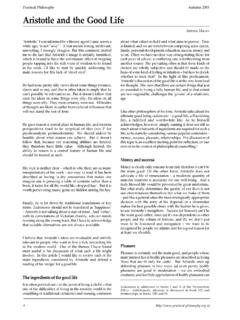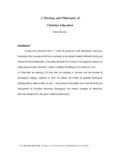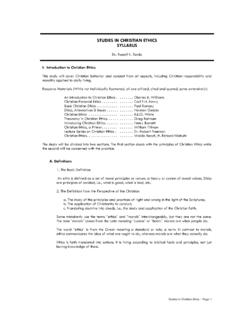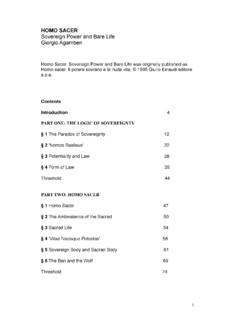Transcription of RXFILES TRIAL SUMMARY O P B LK N 2012 F …
1 RXFILES TRIAL SUMMARY ORIGINALLY PREPARED BY: M JIN, REVISED BY: L KOSAR UPDATED NOV 2012 Page 1 of 3 aristotle : Apixaban vs Warfarin in patients with Atrial Fibrillation 1 Apixaban for Reduction In STroke and Other ThromboemboLic Events in Atrial Fibrillation BOTTOM LINE In atrial fibrillation (AF) patients with an risk of stroke (mean CHADS2 score ): Apixaban 5mg po BID was superior to warfarin for stroke or systemic embolism (NNT=167 years) Apixaban, compared to warfarin, had: - stroke (NNT=175 ), hemorrhagic stroke (NNT=238 ) & mortality (NNT=132 ) - bleeding major (NNT=67 ), intracranial (NNT=128 ), other & any bleeding & discontinuation rates (NNT=45 ) Net clinical benefit stroke, systemic embolism, major bleeding or death from any cause favours apixaban over warfarin (NNT=56 years) At time of publication, apixaban is not approved by Health Canada for stroke prevention in AF patients.
2 $150 290/month. BACKGROUND Vitamin K antagonists (VKA) are used to the risk of stroke in AF patients; however, these agents require frequent monitoring, interact with drugs/food, & require several days of therapy to become therapeutic/discontinuation before clearing the body. New oral anticoagulants (apixaban ELIQUIS, dabigatran PRADAX2,3 & rivaroxaban XARELTO4,5) are alternatives to VKA, such as warfarin. Apixaban ELIQUIS is a new direct oral factor Xa inhibitor. AVERROES: apixaban 5mg bid was superior to ASA 81 324mg/d in AF patients. Stroke/systemic embolism: HR (95% CI ), p< , NNT=45. Major bleeding & intracranial hemorrhage: NS. Study stopped early for benefit, mean follow up = yrs. 6 TRIAL BACKGROUND 7 DESIGN: randomized, multi centre 39 countries, non inferiority with pre designed superiority 1 , major bleeding & mortality, double blinded, double dummy intention to treat controlled TRIAL with concealed allocation.
3 Funded by Bristol Myers Squibb & Pfizer. INTERVENTION: apixaban 5mg* po twice daily versus dose adjusted warfarin (INR 2 3 measured 1 month) *apixaban po twice daily in patients who had 2 of the following: age 80 years, body weight 60kg, or Scr 133umol/L INCLUSION: permanent or persistent AF or flutter ECG at enrolment, or AF or flutter ECG or as an episode 1 minute on rhythm strip/Holter monitor/intracardiac recording on 2 separate occasions at least 2 weeks apart in 12 months before enrolment; age 18 yrs; 1 of the following stroke risk factors: age 75 years, prior stroke/TIA/systemic embolus, symptomatic HF within 3 months or LVEF 40%, DM or HTN requiring pharmacological treatment; women contraception required if childbearing. EXCLUSION: AF/atrial flutter due to reversible causes eg, thyrotoxicosis, pericarditis; planned ablation procedure AF or atrial flutter; bleeding risk eg, previous intracranial hemorrhage; conditions other than AF that require chronic anticoagulation eg, prosthetic mechanical heart valve; required ASA >165 mg/d; treatment with both ASA + thienopyridine clopidogrel, ticlopidine; recent stroke within 7 days; infective endocarditis active; mitral stenosis moderate/severe; uncontrolled HTN SBP>180 mmHg or DBP > 100 mmHg; major surgery planned; hemoglobin <90g/L; platelet 100,000/mm3; liver enzymes ALT/AST>2xULN or total bilirubin ; renal insufficiency Scr>221umol/L or CrCl<25mL/min; active alcohol/drug abuse/psychosocial reasons that make study participation impractical; inability to comply with INR monitoring; life expectancy 1 year.
4 Or unapproved investigation drug or device in past 30 days. POPULATION at baseline: n=18,201 non valvular AF pts at risk of stroke AF ~85% persistent/permanent, ~15% paroxysmal; CHADS2 mean = , CHADS2 score 34% =1, ~36% =2, 30% 3 Median age 70yrs, age 75yr 31%; ~65% k; median weight 82kg; median systolic blood pressure 130mmHg History of stroke/TIA/systemic embolism 19%, HF 35%, HTN 87%, DM 25%, MI ~14%, bleeding ~17%, VKA use >30 days 57% Renal function: CrCl >80mL/min 41%, CrCl >50 80mL/min ~42%, CrCL >30 50mL/min 15%, CrCl 30mL/min Baseline medications: ACE I 70%, ASA 31%, amiodarone 11%, blocker 63%, CCB 30%, clopidogrel , digoxin 32%, gastric antacid drugs 18%, NSAIDS 8%, statins 45% RESULTS follow up: median years TABLE: EFFICACY & SAFETY SUPERIORITY DATA CLINICAL ENDPOINTS APIXABAN (n=9120) WARFARIN (n=9081) HAZARD RATIO (95% CI) COMMENTS PRIMARY ENDPOINT Stroke or Systemic Embolism {n=212} {n=265} ( ) 167 SECONDARY ENDPOINTS.
5 EFFICACY Stroke {n=199} ( ) {n=250} ( ) ( ) 175 Ischemic/Non specified stroke {n=162} ( ) {n=175} ( ) NS Hemorrhagic stroke {n=40} ( ) {n=78} ( ) ( ) 238 Systemic embolism {n=15} ( ) {n=17} ( ) NS Myocardial Infarction {n=90} ( ) {n=102} ( ) NS All Cause Mortality {n=603} ( ) {n=669} ( ) ( ) (p= )132 ADVERSE EVENTS BASED ON N=9088 IN APIXABAN ARM & N=9052 IN WARFARIN ARM Major Bleed* {n=327} ( ) {n=462} ( ) ( ) 67 Intracranial {n=52} ( ) {n=122} ( ) ( ) 128 Other location {n=275} ( ) {n=340} ( ) ( ) 137 Gastrointestinal {n=105} ( ) {n=119} ( ) NS Any bleeding {n=2356} ( ) {n=3060} ( ) ( ) 13 APIXABAN VS WARFARIN: - stroke or systemic embolism- stroke, hemorrhagic strokes & mortality - major bleed, intracranial, other & any bleeding - net clinical outcomes & discontinuation rates OTHER COMMENTS: - Lower apixaban dose BID: n=428 ( ).
6 - Lost to follow up: 69 Missing data: 380 pts ( ). - Warfarin TTR: median 66%, mean RXFILES TRIAL SUMMARY ORIGINALLY PREPARED BY: M JIN, REVISED BY: L KOSAR UPDATED NOV 2012 Page 2 of 3 TABLE: EFFICACY & SAFETY continued CLINICAL ENDPOINTS APIXABAN (n=9120) WARFARIN (n=9081) HAZARD RATIO (95% CI) COMMENTS NET CLINICAL OUTCOMES Stroke, systemic embolism, or major bleed {n=521} ( ) {n=666} ( ) ( ) 61 Stroke, systemic embolism, major bleeding, or death from any cause {n=1009} ( ) {n=1168} ( ) ( ) 56 Discontinuation rate { ) { } p= 45 SUB GROUP ANALYSES: - for major bleeding in pts who did not have DM (p= ) & pts with moderate or severe renal impairment { 50mL/min} (p= ) *Major Bleeding: Hemoglobin 20g/L, transfused 2units, fatal bleeding or 1 critical site=intracranial, intraspinal, intraocular, pericardial, intraarticular, intramuscular with compartment syndrome, retroperitoneal STRENGTHS, LIMITATIONS, & UNCERTAINTIES STRENGTHS: Important clinical endpoints ( stroke & bleed) Both study arms were blinded Included patients with low moderate high risk of stroke Warfarin was within therapeutic range 66% of the study period ACTIVE W , RELY 64%, ROCKET 55% LIMITATIONS: ~ 31% of patients were on concomitant aspirin therapy Used intention to treat without per protocol analysis (per protocol is generally recommended in non inferiority trials)8, but did include modified intention to treat for bleeding.}
7 UNCERTAINITIES: Drug not yet studied in patients with CrCl <25mL/min, Scr >221umol/L or liver disease? Drug interactions? No antidote for reversing bleeding with apixaban Lack long term data & real world experience with apixaban Risk of bleeding in patients with AF & ACS: aristotle bleeding in AF pts, APPRAISE bleeding post ACS. - APPRAISE apixaban 5mg po bid added to antiplatelet therapy in high risk patients after ACS. Rate of major bleeding events (HR= 95% CI , NNH=63) with NS in recurrent ischemic events vs placebo; study stopped early because of harm; follow up median=241 RXFILES RELATED LINKS Atrial Fibrillation Treatment Overview Atrial Oral Antiplatelet & Antithrombotic Agents Comparison Chart Canadian Family Physician RXFILES : Article Oral anticoagulation in atrial fibrillation RELY (dabigatran PRADAX vs warfarin in AF) TRIAL SUMMARY LY TRIAL ROCKET AF (rivaroxaban XARELTO vs warfarin in AF) TRIAL SUMMARY AF ACTIVE A (ASA clopidogrel PLAVIX in AF) & ACTIVE W (ASA + clopidogrel PLAVIX vs warfarin in AF) TRIAL SUMMARY A TRIAL RACE II (lenient vs strict rate control in AF) TRIAL SUMMARY II PALLAS (dronedarone MULTAQ in permanent AF)
8 TRIAL SUMMARY TRIAL % =non formulary = not covered by NIHB k= male ACE I=angiotensin converting enzyme inhibitor ACS=acute coronary syndrome AF=atrial fibrillation ALT=alanine aminotransferase AST=aspartate aminotransferase ASA=acetylsalicylic acid blocker=beta blocker CCB=calcium channel blocker CHADS2=congestive heart failure, hypertension, age >75 years, diabetes mellitus, stroke or transient ischemic attack CI=confidence interval CrCl=creatinine clearance DBP=diastolic blood pressure DM=diabetes mellitus ECG=electrocardiogram HF=heart failure HR=hazard ratio HTN=hypertension INR=international normalized ratio LVEF=left ventricular ejection fraction MI=myocardial infarction NNT=number needed to treat NNH=number needed to harm NS=not statistically significant NSAIDs=nonsteroidal anti inflammatory drugs pts=patients SCr=serum creatinine SBP=systolic blood pressure TIA=transient ischemic attack TTR=time in therapeutic range ULN=upper limit of normal VKA=vitamin K antagonist yrs=years DISCLAIMER: The content of this newsletter represents the research, experience and opinions of the authors and not those of the Board or Administration of Saskatoon Health Region (SHR).
9 Neither the authors nor Saskatoon Health Region nor any other party who has been involved in the preparation or publication of this work warrants or represents that the information contained herein is accurate or complete, and they are not responsible for any errors or omissions or for the result obtained from the use of such information. Any use of the newsletter will imply acknowledgment of this disclaimer and release any responsibility of SHR, its employees, servants or agents. Readers are encouraged to confirm the information contained herein with other sources. Additional information and references online at Copyright 2012 RXFILES , Saskatoon Health Region (SHR) ADDITIONAL REFERENCES: ACCF AHA HRS Atrial Fibrillation 2011 Focused Update. Circulation 2011. Wann LS, Curtis AB, January CT, et al. 2011 ACCF/AHA/HRS focused update on the management of patients with atrial fibrillation (updating the 2006 guideline): A report of the American College of Cardiology Foundation/American Heart Association Task Force on Practice Guidelines.
10 Circulation 2010; DOI: ) Avorn Jerry. The Relative Cost Effectiveness of Anticoagulants: Obvious, Except for the Cost and the Effectiveness. Circulation 2011, 123: 2519 2521. Beasley BN, Unger EF, Temple R. Anticoagulant options Why the FDA approved a higher but not a lower dose of dabigatran. New Engl J Med 2011; DOI: Bovio JA, Smith SM, Gums JG. Dabigatran etexilate: a novel oral thrombin inhibitor for thromboembolic disease. Ann Pharmacother. 2011 May;45(5):603 14. Cairns JA, Connolly S, McMurtry S, et al. CCS Atrial Fibrillation Guidelines Committee. Canadian cardiovascular society atrial fibrillation guidelines 2010: prevention of stroke and systemic thromboembolism in atrial fibrillation and flutter. Can J Cardiol. 2011 Jan Feb;27(1):74 90. Callahan T, Baranowski B. Managing newly diagnosed atrial fibrillation: Rate, rhythm, and risk. Cleve Clin J Med. 2011 Apr;78(4):258 64.
